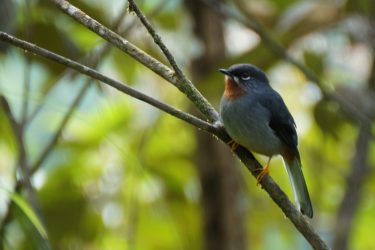In a series of blogs, Ed Drewitt freelance naturalist, broadcaster and wildlife detective takes us through the St Lucia Birding experience. In this edition he describes that first morning at Anse Chastanet.
Lead Photo: Grey Kingbird, Credit: Ed Drewitt
As dawn breaks and the sun quickly rises at Anse Chastanet, there is St Lucia’s very own dawn chorus to listen to. The giddy chuckling of Grey Kingbirds is quickly followed by the coo-ing of Zenaida Doves and drawn out squeaks of Bananaquits. The written words of bird songs and calls can never do them justice and the best way to familiarize yourself with their sounds is to look them up at www.xeno-canto.org. The varied, sweet song of the Tropical Mockingbird punctuates the chorus; the birds themselves might be spotted towards the top of a tree. There is often one singing between the Treehouse Restaurant and the beach. The Grey Trembler meanwhile has an equally sweet bubbly song that travels far.

The time before breakfast, when it is just getting light and the temperature is cool, is a good time to be looking for these birds, particularly if they are singing and in a fixed location. Grey Kingbirds, large flycatchers with white breasts, grey back and dark band across their eyes, are often perched out on open branches or nearby electricity wires. They soon go quiet, busy feeding on emerging insects as the sun comes up and the temperature rises.

The Zenaida Doves are quiet shy doves, although pairs will often peck away at the ground as you walk by. They are similar in size and color to Collared Doves or Mourning Doves. Look for the pretty purple-pink flush of iridescence on their necks and flash of white in their wings when they take off. They dwarf the diminutive Common Ground Doves which are more likely to be found on the beach first thing feeding on seeds and fruits. Their larger cousins the Scaly-naped Pigeons are very shy and tend to be spotted at the tops of the tall trees between the front entrance and the upper parts of Anse Chastanet, towards Jade Mountain. They are a much darker blue-grey color with a head and neck the shade of red wine, a bright red eye and a yellow beak.

The Tropical Mockingbird is a long, slim grey bird with a paler breast and a long tail with white flashes. They can be trickier to see – look for them skulking in the bushes or along the edges of the trees between Jade Mountain and the beach.

The Grey Trembler is unmistakable as the trembling of their wings catches your eye. You may then notice their long-curved beak and yellow eye. The trembling helps tremblers keep in touch with each other, the equivalent of birds calling to each other by sound.
Ed Drewitt is a freelance naturalist, broadcaster and wildlife detective
Learn More About Bird Watching at Anse Chastanet here

